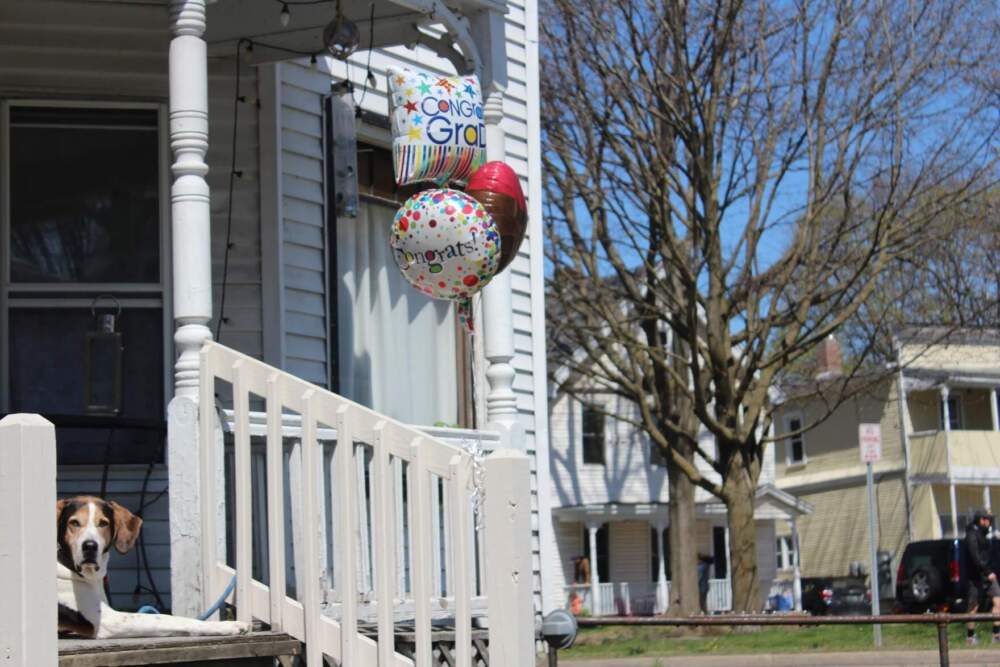Advertisement
The incentive problem keeping landlords from taking climate change action

Connor rents an upstairs apartment in an old house in the village of Pittsford, Vermont, with his girlfriend. It’s a two-bedroom and they like the location. He says his landlords are great, but asked that we just use his first name.
He grew up in the area and just recently moved back to Central Vermont. He’s hoping to stay, but living there has been more expensive than he expected, partly because, like a lot of people renting in rural New England, he heats with fuel oil.
“You truly never know how much it’s going to cost,” he said. “And if you’re relying on paycheck to paycheck and you don't know if it’s going to be a warm winter or a cold winter, not being able to plan for those expenses can be tough.”
In New England, homes and buildings are the second-biggest source of greenhouse gas emissions, and one of the most challenging places to cut emissions from buildings is in rental properties.
In Vermont, rentals account for about a quarter of the housing units and it’s common for renters to pay their own energy bills.
Colin Netzley used to rent an old house in Craftsbury, Vermont, that was heated with fuel oil. On one particularly cold winter, heating fuel cost him more than $400 a month – nearly half what he paid in monthly rent.
A local chapter of the Maine nonprofit Window Dressers helped him get window inserts for free that slide directly into a window frame and can be installed without screws or other hardware. Because the inserts are so low-impact, his landlord supported the project.
Netzley didn’t keep track of how much he saved after that on his energy costs, but he said the difference they made for his comfort was striking.
“There’s a big difference between not feeling any draft and, you know, being bundled up in the armchair trying to read your book, but the arm that’s exposed is covered in goosebumps and your hair is shifting in the slight breeze that the window is just letting through,” Netzley said.
The split incentive for landlords and renters
A big part of the problem for renters is something experts call “the split incentive.”
“The split incentive means that if the renter is paying the utility bills, the landlord has no incentive to invest and pay for the improvements that would save the renter on their utility bills,” said Carlos Martín, who leads the Joint Center for Housing Studies at Harvard.
He says part of the challenge, from an economic perspective, is the problem persists even if a landlord covers the cost of energy or decides to make an investment in weatherization or electrification.
If the landlord pays the heating bill, ”The landlord has an incentive to make improvements but the resulting effects on the renter could be higher rents,” he said.
This is made worse by the fact that New England has some of the oldest housing stock in the country and that most people in the region – including some 60% of households in Vermont – still use fossil heating fuels as their primary source of heat.
On top of being drafty and poorly insulated, many of those older homes have out-of-date or very old electrical panels that require costly upgrades to shift away from fossil fuel heat.
“A lot of us [in New England] are still using heating fuel oil,” Martín said. “As the nation moves towards broader electrification and getting away from any kind of fossil fuel use, unfortunately a lot of our housing is still directly burning and consuming, combusting [fossil fuels] in our homes.”

The cost of this kind of heat can be unpredictable, which presents an added challenge for renters in the region.
Renters in New England and across the country are more likely to be people of color, who have been systematically excluded from home ownership through racist housing policies like redlining.
Renters are also more likely to have less income and are more vulnerable than homeowners are to displacement and other impacts of climate change.
Advocates say renters can benefit tremendously financially from things like home weatherization and electrification, and states are offering some help.
Advice and assistance programs
Lauren Wentz is with Vermont’s statewide efficiency utility Efficiency Vermont, which offers renters free items like LED light bulbs and better shower heads. They also offer rebates for more efficient appliances to landlords and renters alike.
Because renters are often so burdened by their energy expenses, Wentz says efforts like this, and even things you can do for free, like turning your thermostat down at night or unplugging appliances when you’re not using them, really does count towards lowering your emissions and costs.
Plus, there’s the added benefit that you don’t need your landlord’s permission.
She says it’s critical that assistance programs target renters directly and be built to suit their unique situation.
For example, this summer and winter, Efficiency Vermont hopes to roll out a new pilot program that would provide renters with rebates for portable heat pumps that slide right into a window.
The technology is not yet on the mass market, but is being tested in New York state.
But what often makes the biggest difference on a person’s bill are bigger projects — like adding insulation and replacing windows and doors, or installing a heat pump or new hot water heater, or upgrading an outdated electrical panel. Electrification is most effective at reducing emissions and costs if it’s done after a building has been sufficiently weatherized to reduce heat loss.
“The split incentive makes it challenging to do whole building energy efficiency projects unless they are financially supported and incentivized in many of the ways that Efficiency Vermont offers,” Wentz said.
In Vermont, landlords can get their properties weatherized for free through the state’s Weatherization Assistance Program, provided 25% of their tenants are income-qualified. For larger multi-unit buildings, the 3E Thermal Program provides no- or low-cost weatherization and efficiency upgrades, with extra financial support for a project if any resident receives food, housing or fuel assistance.
Pandemic era federal spending brought historic funding for this sort of work. Vermont received nearly $60 million dollars for home weatherization and electrification and roughly $60 million through the federal solar for all program, to help low income households access solar power.
On top of that, the state is in the process of designing a “clean heat standard” – which proponents say, if enacted, would create a steady source of funding to help low income households use less fossil fuels.
Making changes equitably
Some landlords are already doing projects using pandemic era federal funds.
Therisa Shams el-Din Rogers and her husband replaced windows and doors and added insulation to the basement apartment they plan to rent out below their central Vermont home. They’re also installing solar panels on their roof.
They weren’t able to get all the appliances they wanted — in part because some of the ones that qualified for rebates are not accessible for people who are blind, like Therisa’s husband.
“For us, the concern about the environment is a large one,” she explained. “But as with all people, we have limited funds. So we had to make some decisions that we really didn’t like.”
But she’s glad that all the resources she’s able to access to improve her home and lower her emissions will help her renter too.
As more funding for this work becomes available, Rogers hopes the entities delivering it will focus on making it accessible to people who have historically had less access to the benefits of electrification and home weatherization, like people who have low incomes and people of color. Rogers thinks it will help to have community engagement and efforts to ensure the tools available to sort through rebates and tax credits are straightforward and easy to navigate.
5 ways to lower your energy costs and carbon emissions as a renter
Reach out to your state’s Weatherization Assistance Program
Getting the entire building weatherized – also called “whole building weatherization” – is probably the best way to make the biggest dent in lowering your heating costs.
In Vermont, any rental building for which 25% of the tenants are income-qualifying is eligible to be weatherized for free (with landlord permission).
Nationwide, the Department of Energy estimates that this saves the average household almost $400 per year in energy costs. That figure is likely higher in New England, where most people heat with price-volatile fossil fuels like fuel oil and propane and we have a long heating season.
And even better – according to Capstone Community Action, which does this work in central Vermont – in most cases, tenants don’t have to relocate while their unit is weatherized. That’s a big win in a tight housing market
Start a conversation with your landlord — if you feel comfortable doing so
Depending on your relationship, this can be tough. The electrification nonprofit Rewiring America has a great template you can use to start the conversation. You can find that here.
And if you have an appliance that needs to be replaced – a refrigerator, stove, boiler or furnace – that can be a great opportunity to ask your landlord to consider a more efficient option.. There are rebates that make some of those appliances cost competitive with their fossil fuel or less efficient counterparts.
Start with the small stuff. It adds up!
Here are some recommendations from Efficiency Vermont, and Efficiency Maine. In your state, you could qualify for free LED light bulbs or more efficient shower heads. In some states, renters are also eligible for DIY rebates to do small projects in your space yourself.
If your building does not qualify for free weatherization, reach out to a local chapter of Window Dressers — or explore on-bill financing through your utility
The Maine-based nonprofit teaches community members how to build window inserts that slide directly into a window frame and don’t require any screws to install — making them easy for landlords to sign off on.
In Vermont, local chapters are often able to help renters get inserts for free. You can find out about community builds in Vermont, New Hampshire and Maine here.
In Vermont, several utilities are experimenting with a polivy called “on-bill financing” that allows customers who are renters with very high electric or heating bills but who make too much to qualify for free weatherization, to finance the project over the long term through their utility, via payments on their gas or electric bill.
This sort of arrangement works best for renters whose monthly energy bills are so high that their monthly savings from weatherization outweigh the added payments on their monthly bill. If renters move out, the “tariff” agreement stays with the property, until the upgrades are paid off.
Use Rewiring America’s incentive calculator to find out what rebates you qualify for and who offers them. Contact your local efficiency utility
In this moment of unprecedented federal funding for home electrification and weatherization, it can be hard to know where to look for incentives — and easy to assume they’re not for renters.
But landlords and renters can access incentive programs — and as state energy offices continue to design programs to roll out IRA funding in this space, expect more incentives for low- and moderate- income households to come online this year.
Depending on where you live, Rewiring America has a great incentive calculator to help you figure out based on your income, your utility, your zip code and whether you’re a renter or homeowner what state, federal and utility-scale incentives you qualify for.
From there, a local efficiency utility can help you make a plan to layer incentives strategically and find out how much you qualify for.
This story is a production of the New England News Collaborative. It was originally published by Vermont Public.